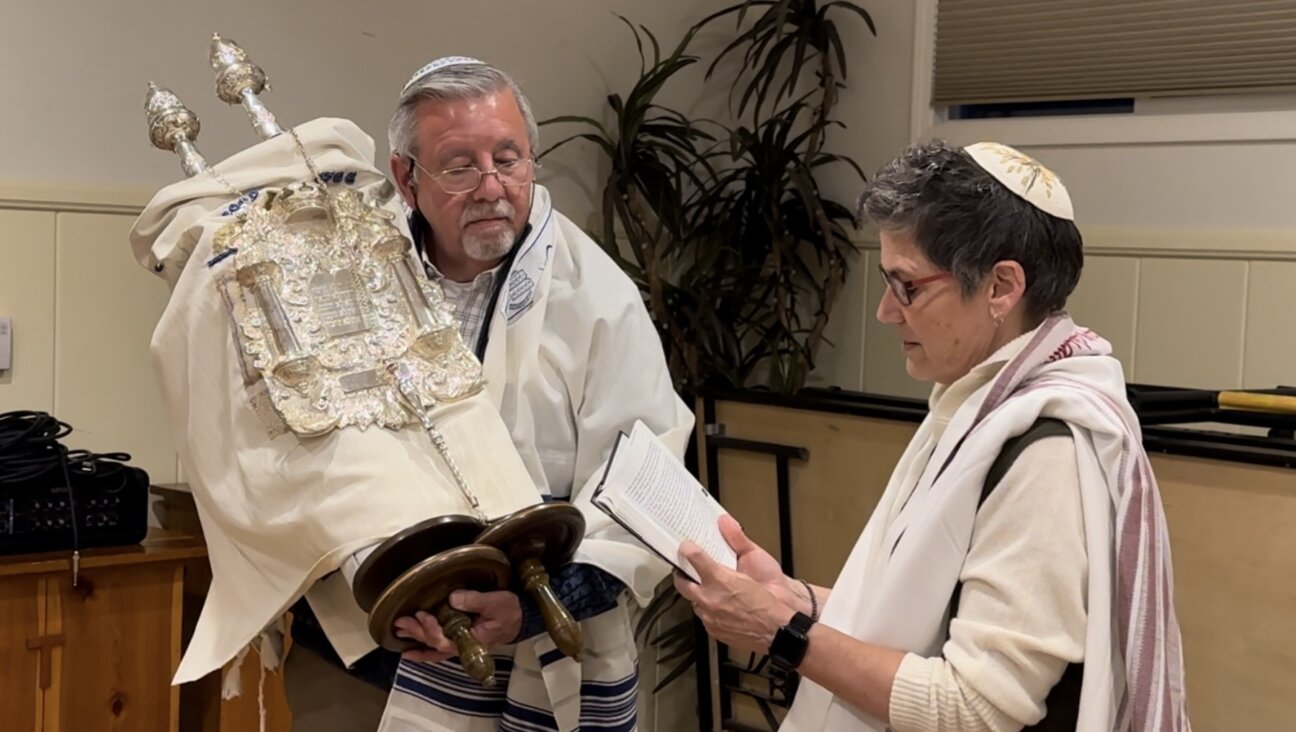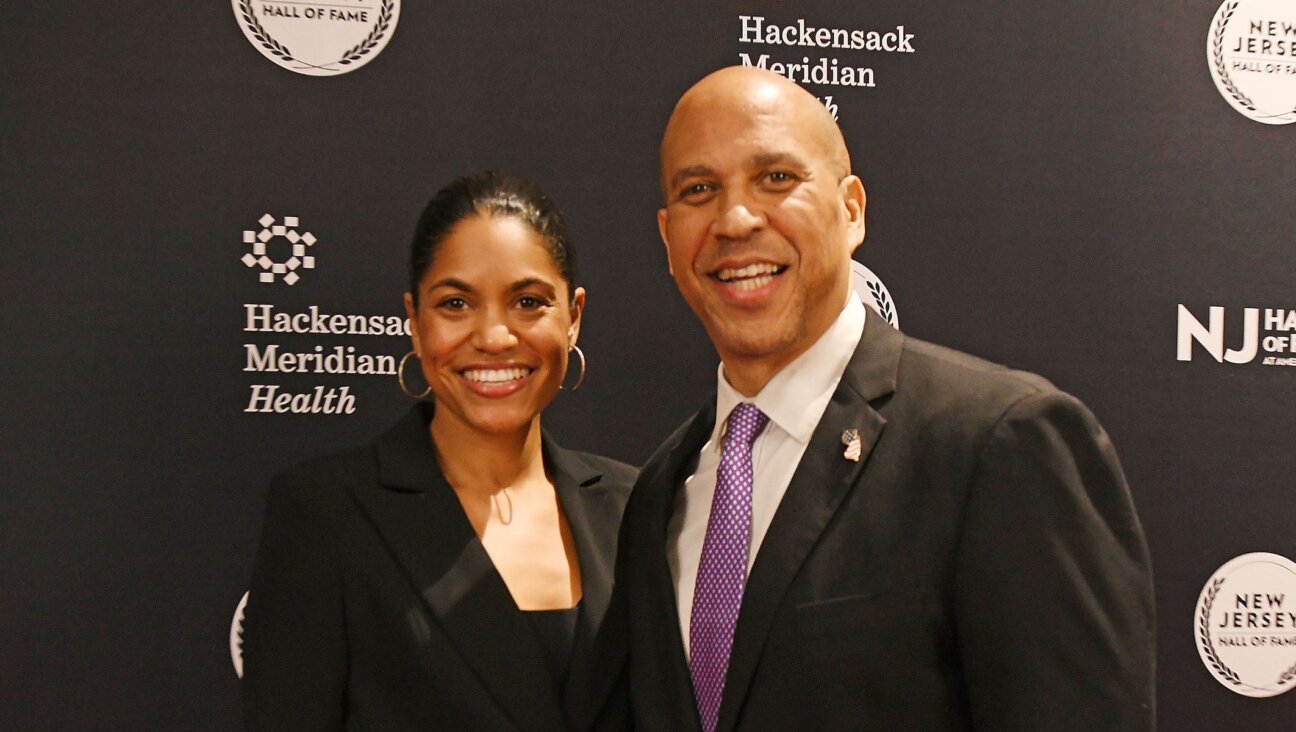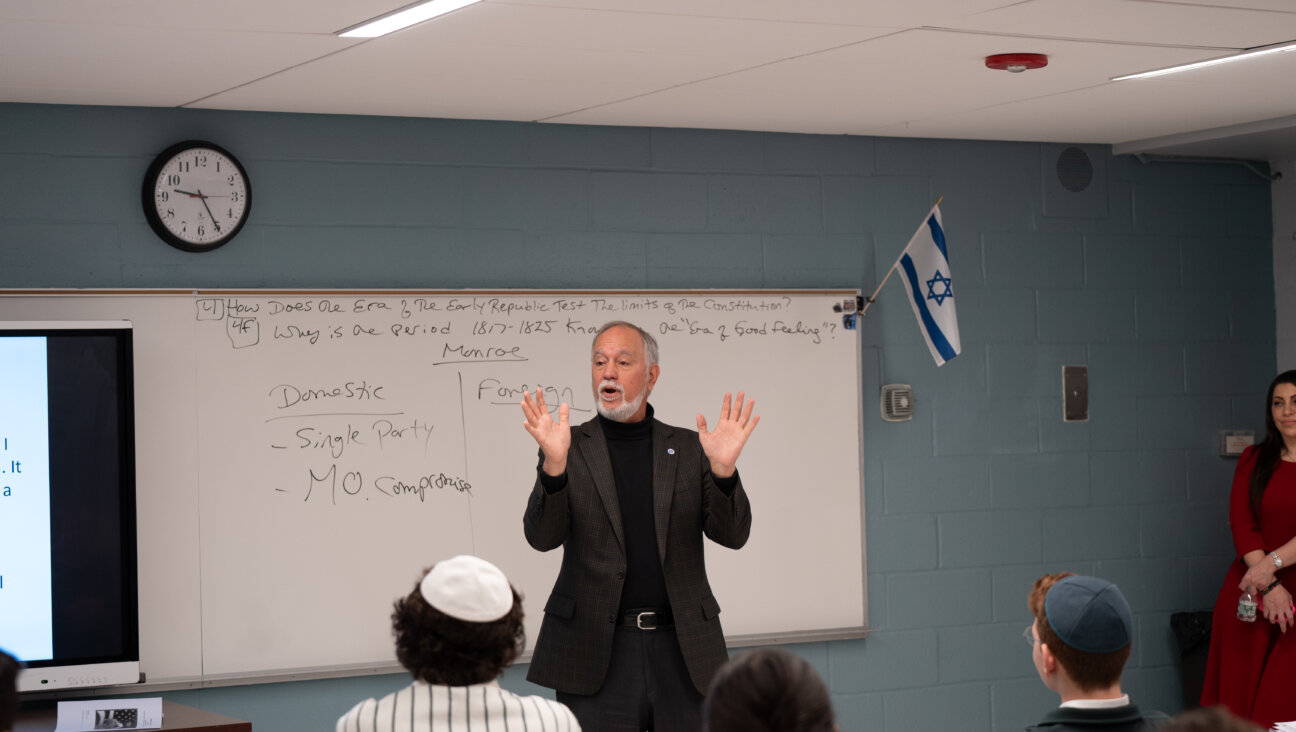‘It was a disaster’: Inside a fierce battle over antisemitism at CUNY
“This just seems to be the after-party of the overreaction to BDS,” said one professor

Photo-illustration by Getty Images, The Forward
Friends of Nerdeen Kiswani, a law student at the City University of New York, started texting her with concern last week after an advertisement appeared on social media with a menacing photograph of her shouting into a microphone. “Nerdeen Kiswani attacked Jews,” the ad read.
“While they’re browsing their stories it just pops up: a darkened image of me with the contrast increased to play into some racist trope, like ‘dark angry Arab,” Kiswani recalled in an interview.
The advertisement, paid for by an anonymous organization called BDS Report, was released as the CUNY student government prepared to consider dueling resolutions addressing antisemitism at a meeting last weekend. It was only the most striking of what students on both sides said was a flurry of outside advocacy that poisoned an already deeply divisive debate.
Both of the resolutions, the latest in a spate of similar initiatives at campuses across the country, dealt with the very definition of antisemitism — a seemingly esoteric issue that has increasingly become a proxy for larger questions concerning the polarizing politics of the Israeli-Palestinian conflict, identity and free speech. And, after the intervention of national pro-Israel groups, both resolutions failed to pass at a contentious, hours-long Zoom meeting of CUNY’s Student Senate on Sunday.
“It was a disaster,” said Aharon Grama, a member of the Senate’s steering committee.
One resolution would have had the entire CUNY system adopt the International Holocaust Remembrance Alliance definition of antisemitism; the other promoted a different definition backed by a group of anti-Zionist Jewish students and Students for Justice in Palestine. The conflagration at one of the nation’s most diverse and democratic institutions of higher education may preview the future of Israel debate on campus, as attention shifts away from the movement to boycott the Jewish state and toward policing pro-Palestinian activism.
Student governments at 28 colleges and universities have adopted the IHRA definition — which states that anti-Zionism and certain harsh criticism of Israel is often antisemitic — since 2017, including nine this school year, according to a list maintained by the American Jewish Committee. In March, the University of Minnesota embraced it with a school-wide referendum after a pitched fight.
For pro-Israel activists, these initiatives are a natural extension of their opposition to the Boycott, Divestment and Sanctions movement. David Benger, a research fellow at Harvard who is working on a book about the Israeli-Palestinian conflict on college campuses, said that they have given Jewish students who were pushed out of progressive spaces and coalitions because of their Zionism a way to confront the increasingly vitriolic nature of the campus debate over Israel.
“They knew what was happening to them was antisemitic but they didn’t have a tool that would be persuasive,” Benger said. “And now they do.”
Others are more skeptical. Eric Alterman, a professor at Brooklyn College — one of CUNY’s 25 campuses — said many Jewish organizations that had mobilized aggressively against BDS have been spinning their wheels as the movement has stalled in recent years. Now, Alterman said, such pro-Israel groups are raising what he sees as spurious alarm over campus antisemitism in order to reanimate their supporters.
“This just seems to be the after-party of the overreaction to BDS,” Alterman said.

Counter-demonstrators protest across the street from a rally in support of the Palestinian people in the wake of the recent violence in the Gaza Strip, during a rally in Times Square, May 18, 2018 in New York City. Photo by Getty Images
While many of those watching from the outside framed the situation at CUNY in the similar stark terms of the BDS debate — Jewish students trying to fight antisemitism stymied by Palestinian activists — the students involved paint a more complicated picture.
It started in January 2020, when a Jewish CUNY law student named Rafaella Gunz wrote an op-ed describing the school as a hotbed of antisemitism. The piece cited Kiswani’s activism, as described by the far-right Canary Mission website, as well as what Gunz described as broader hostility toward Israel on the campus. Scores of progressive student organizations responded in an open letter, and Gunz left CUNY the next month, saying she had been harassed.
The incident renewed concerns that CUNY was a dangerous place for Jews — and that students expressing legitimate criticism of Israel might be exposed to damaging accusations of antisemitism.
“To just say we’re antisemitic because we’re SJP is a form of Islamophobia and anti-Palestinian racism,” Kiswani said in a recent interview, referring to Students for Justice in Palestine. “It just supposes that our ideology, our politics, are just driven by bigotry rather than actual political beliefs and experiences.”
Then, last fall, CUNY’s Jewish Law Students Association amended its constitution to become the first such group in the country to declare itself anti-Zionist. It started working with Students for Justice in Palestine to develop a definition of antisemitism that the administration could use to adjudicate claims of bigotry. Meanwhile, in November and December, three CUNY campuses — Brooklyn College, City College and Baruch College — adopted the IHRA definition, which has been endorsed by dozens of countries around the world and many mainstream American Jewish organizations.
Yehuda Wexler, a student and delegate from Baruch College, introduced a resolution supporting IHRA to the CUNY-wide Senate, which represents the university’s 500,000 students. Wexler said he was motivated by an event last year when a Senate employee posted an antisemitic video; the staff member apologized, but the Senate took no action and Wexler felt like the incident “was completely swept under the rug.”
But Wexler’s motion ran into a wall of students concerned that the resolution would be used to quash campus activism.
“We were very prepared,” said Adina Marx-Arpadi, who is president of the Jewish Law Students Association and an intern at Palestine Legal, which defends pro-Palestinian activists. Her group released an open letter that called IHRA “useless,” “overbroad,” “imprecise,” and “an attempt to silence Palestine-solidarity efforts by equating anti-Zionism with antisemitism.”
Marx-Arpadi and other Jewish law students drafted a that defined antisemitism as discrimination against Jews “as individuals, groups, or as a collective — because they are Jews,” while defending opposition to Zionism. Students for Justice in Palestine backed the resolution and the flood gates opened — across CUNY and far beyond.

Protesters rally in Manhattan against the closing of some schools and businesses in Jewish neighborhoods in the Brooklyn and Queens boroughs due to a spike in the numbers of Covid-19 cases in these neighborhoods on October 15, 2020 in New York City. Photo by Getty Images
National pro-Israel groups including StandWithUs, Combat Anti-Semitism and BDS Report jumped into the CUNY debate, and framed the alternate definition as a product of Students for Justice in Palestine, a much-maligned group in mainstream Jewish circles. More than 9,000 people signed an online petition, created anonymously, that did the same.
.@CUNYSJP is trying to pressure @CUNYUSS to pass a watered-down definition of antisemitism, so their assault on Jewish life on campus can continue unencumbered. @CUNY must protect the International Holocaust Remembrance Alliance’s working definition of antisemitism.
— Israel War Room (@IsraelWarRoom) April 10, 2021
Marx-Arpadi said these groups ignored the fact that many of the anti-Zionist students promoting the new definition were Jewish.
“That, to me, is antisemitism,” Marx-Arpadi said. “The fact that other Jewish people can’t comprehend that Jews would not agree with them about Zionism — to reconcile this idea, they had to erase us, they had to tell us we’re not Jewish.”
This also meant much of the backlash fell on Kiswani, who opposed the IHRA resolution but had not written the competing definition.
Kiswani, who helped found Within Our Lifetime, a New York group that supports Palestinian resistance against Israel “by any means necessary,” was labeled “antisemite of the year” in 2020 by StopAntisemitism.org, for a video she made waving a lighter at her friend’s Israel Defense Forces sweatshirt. A Jerusalem Post article claimed she “has a storied history of terrorist glorification,” citing photos she had shared on social media of Leilah Khaled and Rasmieh Odeh, members of the Popular Front for the Liberation of Palestine who were, respectively, involved in a hijacking and a bombing targeting Israelis in 1969.
Palestine Legal has defended Kiswani, and pointed to a coordinated campaign against her by an organization tied to the Israeli government that flooded CUNY administrators with emails falsely claiming that she had threatened to set a “pro-Israel student on fire.”
In the days leading up to the Senate debate on the dueling resolutions, Kiswani said, she began receiving harassing and threatening messages online.
“One example of a death threat I got on Twitter was, ‘she should have her neck slashed from ear to ear,” Kiswani said. “Just really graphic stuff.”
Alterman, who has strongly opposed an academic boycott of Israel at Brooklyn College, where he teaches English and journalism, said it was not a coincidence that the non-campus groups had targeted student activists like Kiswani. He said that many pro-Israel groups are scrambling to respond to “a certain kind of criticism of Israel which used to be disqualifying, but no longer is” because of the popularity of leftist politicians like the so-called Squad of congresswomen led by Rep. Alexandria Ocasio-Cortez of New York, and because of “the disaffection of so many young Jews.”
“They’re fighting a rearguard action against the changing norms of the debate,” he explained.
Hillel, the umbrella Jewish college movement, the Anti-Defamation League and other legacy mainstream Jewish organizations that are promoting IHRA have run into organized pushback from progressive Jewish groups, including some liberal Zionist organizations that fought alongside them to oppose BDS, widening the fault lines within the Jewish community.
At CUNY, IfNotNow, Jewish Voice for Peace and Jews for Racial and Economic Justice lined up to oppose the IHRA resolution. J Street U has come out against the definition’s adoption on college campuses generally.

A protestor waves a Palestinian flag while standing atop a truck during rally in support of the Palestinian people in the wake of the recent violence in the Gaza Strip, during a rally in Times Square, May 18, 2018 in New York City. Photo by Getty Images
The actual disagreements over IHRA at CUNY were less stark than they initially appeared from the outside. Grama said he was eager to have his school adopt a strong definition of antisemitism because students often shunned him over his service in the Israel Defense Forces, something that baffled him.
“They don’t know what I did in the IDF,” Grama added. “I was military police. They’re one of the most hated units over there — they put Israeli soldiers into jail for doing crimes.”
Grama said that he also knew of one Jewish faculty member at CUNY who had been pushed out of racial-justice protests because of the professor’s perceived allegiance to Israel. But he said he would have happily supported amendments to the pro-IHRA resolution in order to distinguish between anti-Zionism and antisemitism, or to insert a clause about the Palestinian right to self-determination.
Marx-Arpadi and Kiswani seemed open to collaboration as well, and the two sides were in contact with one another leading up to last weekend’s meeting. But the flood of attacks on Kiswani and other students effectively killed the opportunity to move a joint measure through the University Student Senate.
“Most people in the USS, after they saw that, they took a side immediately,” Grama said, adding that the resolution “failed so miserably because of these organizations that intervened.”
The group that created the ad attacking Kiswani, BDS Report, spent $1,766 targeting it and two other posts to New Yorkers on Facebook and Instagram, according to the platform’s tracking. The group, which primarily monitors attempts to boycott Israel, did not respond to a request for comment.
By the time Sunday’s meeting started, the students supporting the IHRA resolution were still open to making changes to the document, but their opponents said that a swift vote condemning it and supporting the alternate definition was the only way to end what they saw as a campaign of harassment.
“With the hate coming our way we need to pass this with the urgency of now,” Petra Gregory, a delegate from the College of Staten Island, said at the meeting.
The dynamic created some odd situations, including one where Wexler, the Baruch College representative who sponsored the original resolution promoting the IHRA definition, said he understood it “can be harmful to Palestinians and to advocacy.”
“I’ve been listening to you all,” said Wexler, who is also president of Hillel at Baruch. “I’ve learned from you all.”
But the other side would not let him amend his resolution. They did insert a clause in their own version acknowledging that it is antisemitic to force all Jews to answer for Israel’s actions. But Wexler said he still could not support it, because it framed antisemitism primarily as an extension of white supremacy, did not address Holocaust denial, and left out the connection between Jews and Israel.
“Zionism is an essential part of Judaism for me and so many of my peers,” Wexler said. “Labeling that as racism attacks us at the base of our Jewish identity.”
In the end, Wexler’s resolution went down with only one vote in favor. By the time the other resolution came to a vote, after nearly six hours of discussion, it easily won the support of a majority — 21 — of those still on the Zoom call, but that fell short of the necessary quorum.
Marx-Arpadi and Kiswani both said that they are hoping to build off their momentum to perhaps to draft a new resolution focused on defending free speech. This “wasn’t just about providing a definition,” Kiswani said. “It was about emphasizing the need for solidarity between our groups — and that none of us are free until we’re all free.”
Meanwhile, Grama, the delegate who described the whole chapter as a “disaster,” said he hopes that the Senate will be able to pass a meaningful measure dealing with antisemitism in the future.
“Antisemitism should be denounced by all groups and without targeting Palestinians,” Grama said. “I think that’s possible.”















